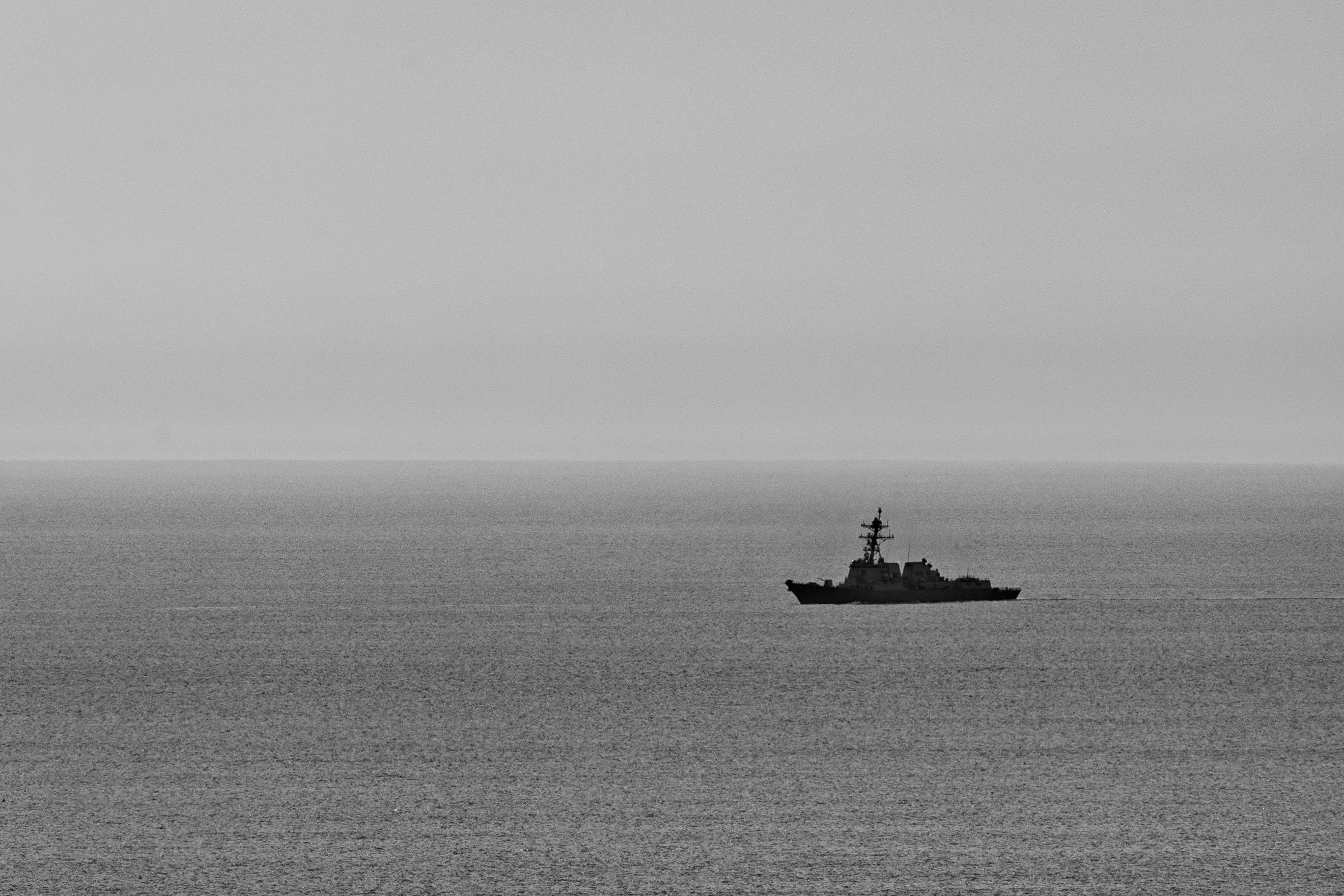
ABOARD GUIDED-MISSILE DESTROYER USS HALSEY OFF THE COAST OF CALIFORNIA – When Cmdr. Amanda Browning joined the Navy, she learned how to drive and operate a ship from a set of CD-ROMs on a computer aboard Ticonderoga-class guided-missile cruiser USS Mobile Bay (CG-53). Twenty years ago, new surface warfare officers learned on the job after a cost-saving decision to trim upfront training, and the results were far from consistent.
Following the 2017 fatal collisions in the Western Pacific that killed 17 sailors, the Navy reversed course and invested billions of dollars in virtual shore trainers on both coasts and made time for new SWOs to get a feel for a 9,000-ton warship in the safety of a trainer.
While SWOs previously trained in an ad-hoc system that left evaluations up to individual ship commanders, young officers now experience an institutionalized training pipeline that leads to multiple go/no-go assessments. Since making those changes, the Navy has had a 99.27 percent pass rate for the first mariner skills assessment, according to a spokesman for Naval Surface Forces.
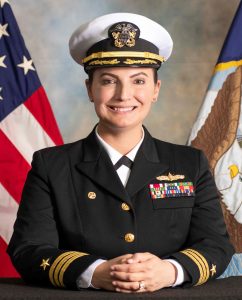
“As of 28 February 2023, 958 officers have attended OOD Phase 2. 951 of 958 officers have passed the mariner skills assessment,” Cmdr. Arlo Abrahamson
told USNI News. “Only seven officers have not passed the assessment by the third attempt and have not gone on to their second division officer tours.”
That new system is developing better young officers who check in to their first ship with more knowledge and skills than SWOs years ago, according to Browning.
“There’s much more of a standard baseline,” the commanding officer of Arleigh Burke-class guided-missile destroyer USS Halsey (DDG-97) said of today’s ensigns.
Young officers today have spent dozens of hours in simulators before they walk aboard their ships, meaning they have a better grasp of seamanship skills and ship driving lingo.
“They show up talking about bearing drift, target angle. I don’t think I really got what that was until I met the ship on deployment and probably a month or two in of on-the-job training, standing watch every day, was I really feeling very comfortable with that,” Browning told USNI News during an interview in her office aboard Halsey.
“Right now, they’re getting enough reps and sets in the trainer to where they can confidently make those reports. And the second thing is the making of the reports – the verbalization of it. So they practice talking Navy talk, which is – it’s not hard, but it’s definitely a lingo. There are phrases that we use that you don’t use driving down the street.”
Mariner Skills Training Center
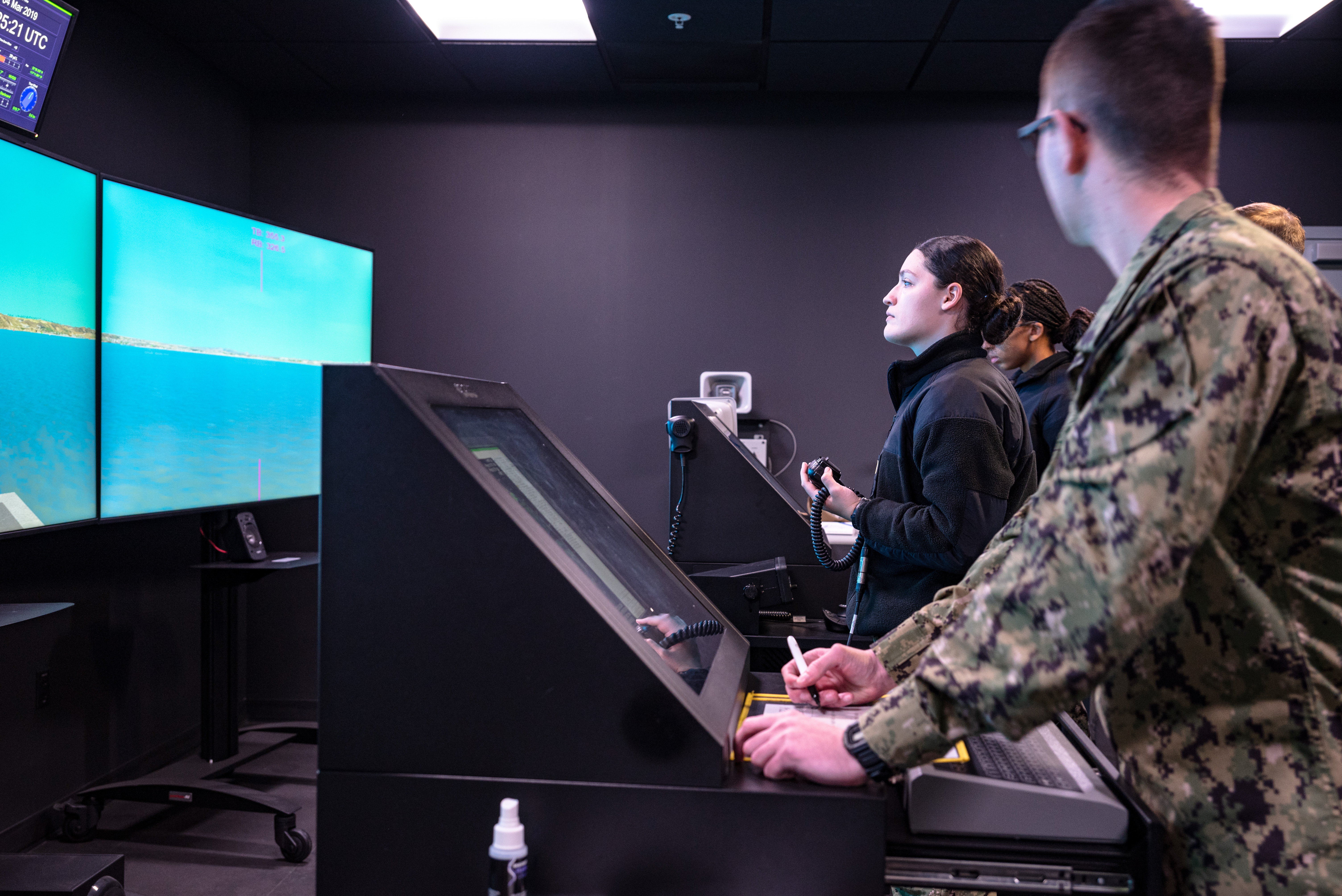
Part of what has helped raise the bar for young officers is the Officer of the Deck Phase I course they go through at the Mariner Skills Training Center. Both San Diego, Calif., and Norfolk, Va., have new facilities with virtual trainers and instructors who teach the course.
“They do really take people … most of whom have no experience doing any sort of ship driving and they teach us the basics,” said Ens. Lucas Arnold, an electronic warfare officer on Halsey who qualified for officer of the deck days before USNI News came aboard.
“I felt when I left the school house – I definitely felt comfortable. I felt like I was ready to come, not take the deck, but I definitely felt ready to be a conn – to stand conning officer.”
After completing the Basic Division Officer Course, which includes some simulator time but mostly focuses on classroom instruction, ensigns go to MSTC for the required OOD Phase I course that the Navy extended from four weeks to six.
“First two weeks you’re going to be doing radar, [maneuvering] boards, all of the basic functions before you get into the scenarios that you’re going to be doing because the following four weeks is just two-a-days of scenarios. So you get a lot of simulator time before coming to the ship,” Lt. Junior Grade Josh Hoefner, a strike officer aboard Halsey who also qualified for ODD in February, told USNI News.
Once the officers get to the ship, they start working on their qualifications. They have 30 months to earn their SWO pin, which requires them to pass three officer of the deck boards and three SWO boards. Many young officers earn their pin in 24 months, Arnold said.
The leg up from the simulators helps elevate a backlog of sailors waiting to get their qualifications, Browning said.
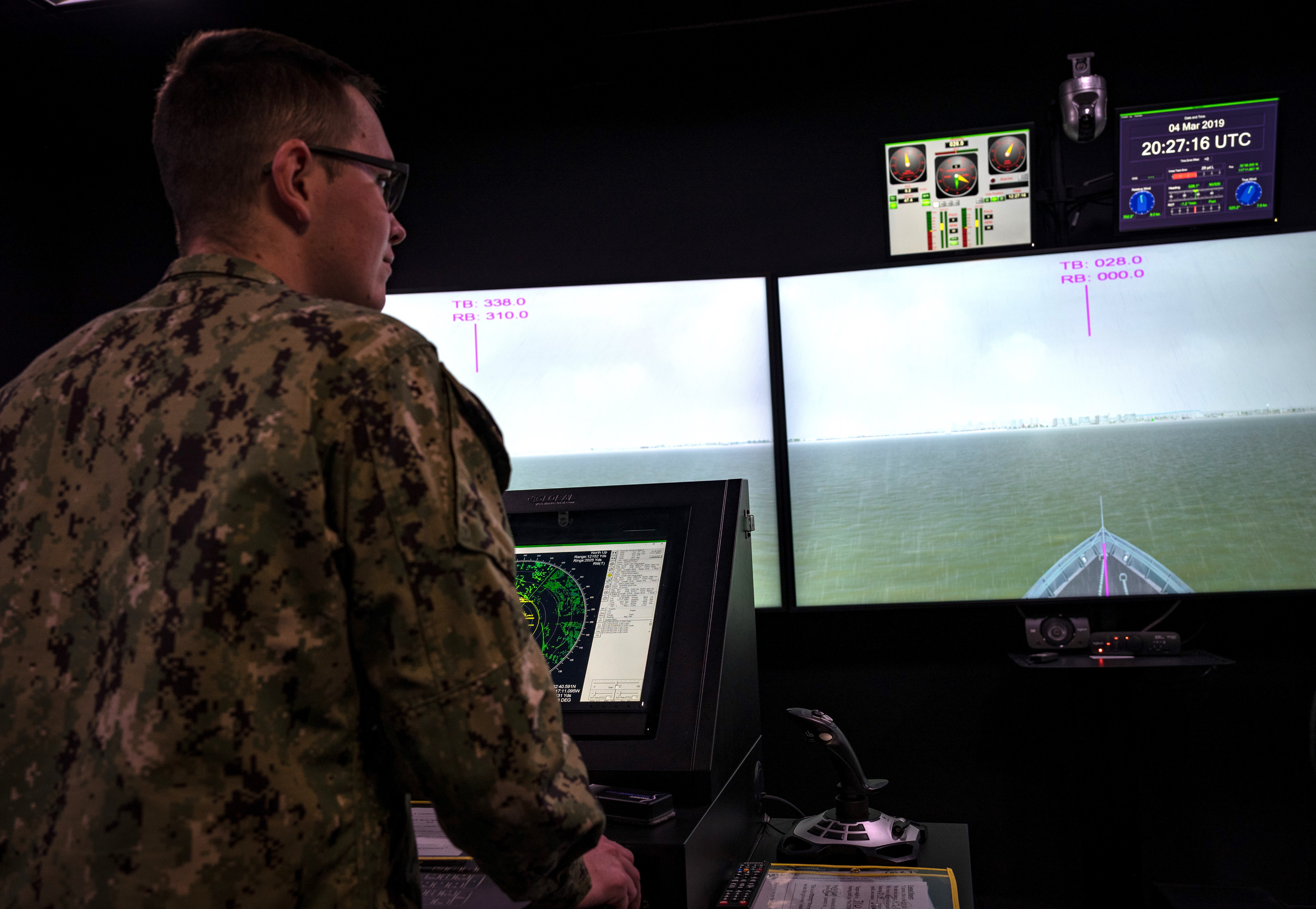
“It would be frustrating and really, honestly, demoralizing if you got stuck in a queue – because you sort of do get stuck in a queue – of when you arrived,” she said. “You would never get processed through fast enough to get enough on-the-job training in that time, that you just show up with now. So it’s really good.”
Container ships and the San Diego-Coronado Bridge appear in the distance on the screens inside the waterfront trainers during a USNI News visit to the training center in San Diego. The simulation creates a virtual navigation bridge for young officers to experience different sea states or environments. This allows them to try new scenarios, like a harbor transit or a contact report, in lower-stakes conditions.
“The simulator gives you the opportunity to make some mistakes that you can’t make in the real world. You know, if you want to try and maneuver and you’re like, ‘how would this work’ You try it in the simulator and you go, ‘okay that really doesn’t work.’ You can’t do that on the ship.” Arnold said.
“And then having someone there to be like, ‘hey, maybe try this’ is where you kind of learn your own style of managing a bridge team too. That’s really important.”
Aboard the Ship
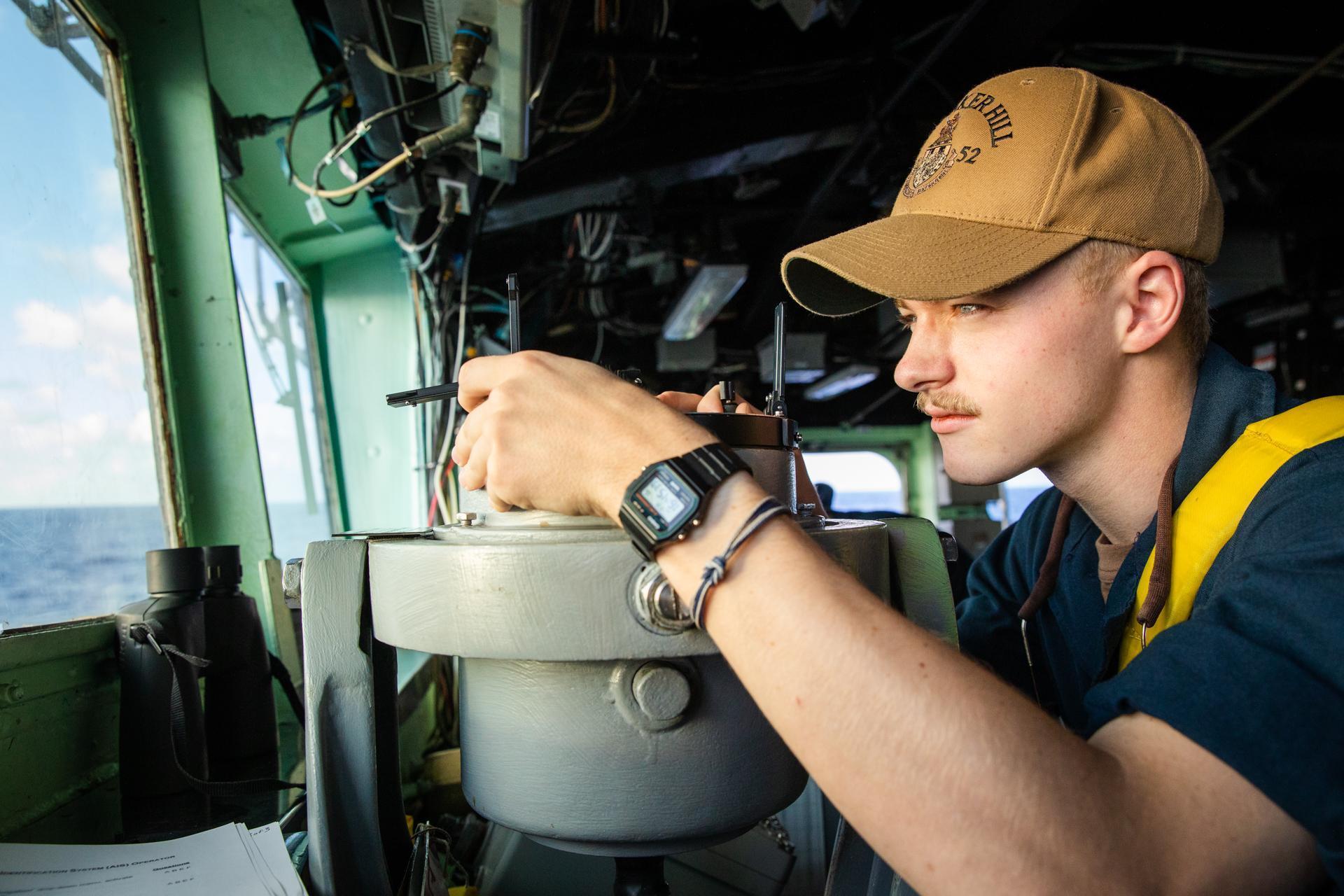
Once young officers finish OOD Phase I, they have the chance to apply what they learned in the MSTC simulators to real-life scenarios when they get underway.
“You hit the ground running I think in all aspects of this job,” Arnold said about getting underway for the first time. “But there’s always someone there to say stop and do something different, or try this.”
First, they typically work under the instruction of a qualified conning officer to learn how to drive the ship.
“You almost feel over-prepared for some of the positions that you’re in because when you get to the ship, you’re not doing anything close to what you were doing [in the simulator.] You’re conning, which has its own aspects to it that are a little challenging,” said Hoefner. “You’re going to be looking out the windows the entire time when you’re on watch. You’re the primary lookout on the ship. You should be training the boatswain lookouts that are rotating through on the bridges.”
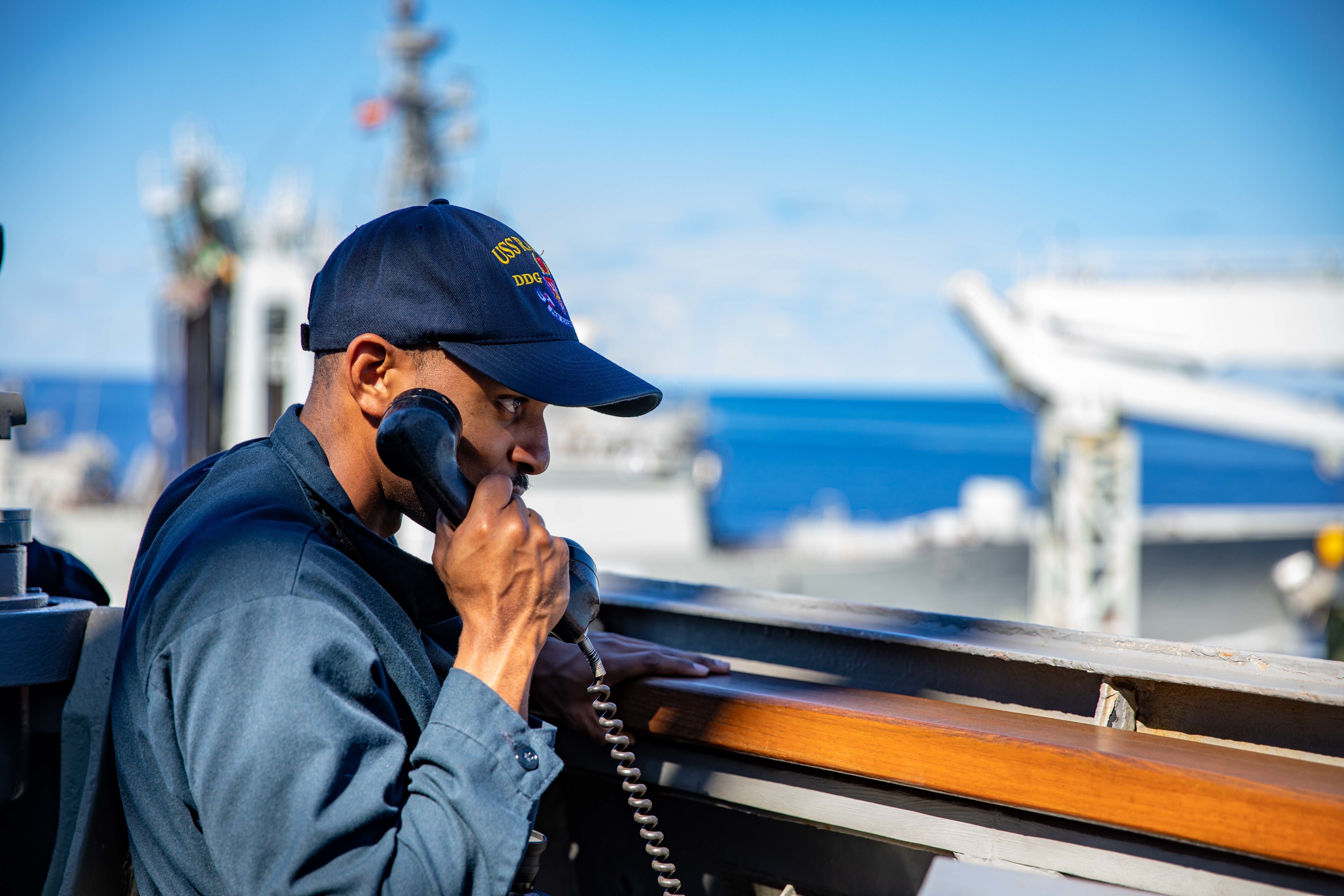
While USNI News was aboard Halsey, the crew was out for its first underway during the basic phase of workups, when they must demonstrate proficiencies to earn certifications, like for man overboard drills.
“Those officers have been onboard less than a month and they can drive a man overboard and meet the time requirements to get a [satisfactory] right out to sea for the first time. It’s their first underway,” CO Browning said.
“That’s not easy. It is incredibly dangerous. And those conns, who haven’t even been underway on a real ship since commissioning, – they’ve been out less than a month – and those are the conns doing it. They’re driving the ship” during man overboard drill certifications.
After several weeks of conning under instruction, officers will start the first board process for conning, which tests them on basic rules of the road and standard commands. Once they pass the conning qualification, they spend more time on the bridge and move on to the helm safety officer qualification. After earning both of those qualifications, they can begin standing junior officer of the deck watches
“That’s really the one where you start learning the bigger picture for running the deck. You start making contact reports to the captain. You start using bridge-to-bridge [communications]. You’re using the radar more. You’re talking on the net to combat and [central control station],” Arnold said.
“And then when you’re comfortable there, you start to stand officer of the deck under instruction. And that’s when you really start studying the nitty-gritty of the standing orders, asking people what kind of questions do they ask on an OOD board. What are their expectations for an OOD? And that’s kind of at the end of a months-long process or a year-long process, usually.”
Nearly two years ago, the Navy rolled out Officer of the Deck Phase II, a three-week course officers take after their first division tours. These courses and the overall revamped training pipeline were meant to address gaps the Navy identified in a 2018 assessment that found inadequacies in ship handling among its junior watch standers.

While the simulators can’t fully replicate real-life bridge situations, the young officers aboard Halsey said they felt ready to begin their qualifications and pursue the SWO pin.
“I think the thing that you really can’t capture in a simulator – nor would you want to – is the responsibility that you feel for having hundreds of lives saying, ‘I trust you to not get me in a dangerous situation,’” Arnold said.
“I don’t think any simulator or any schoolhouse can prepare you for that level of stress, but I think that it can provide you with the basic level of knowledge that you need to build that confidence and then go forward and take the deck in a real scenario.”





